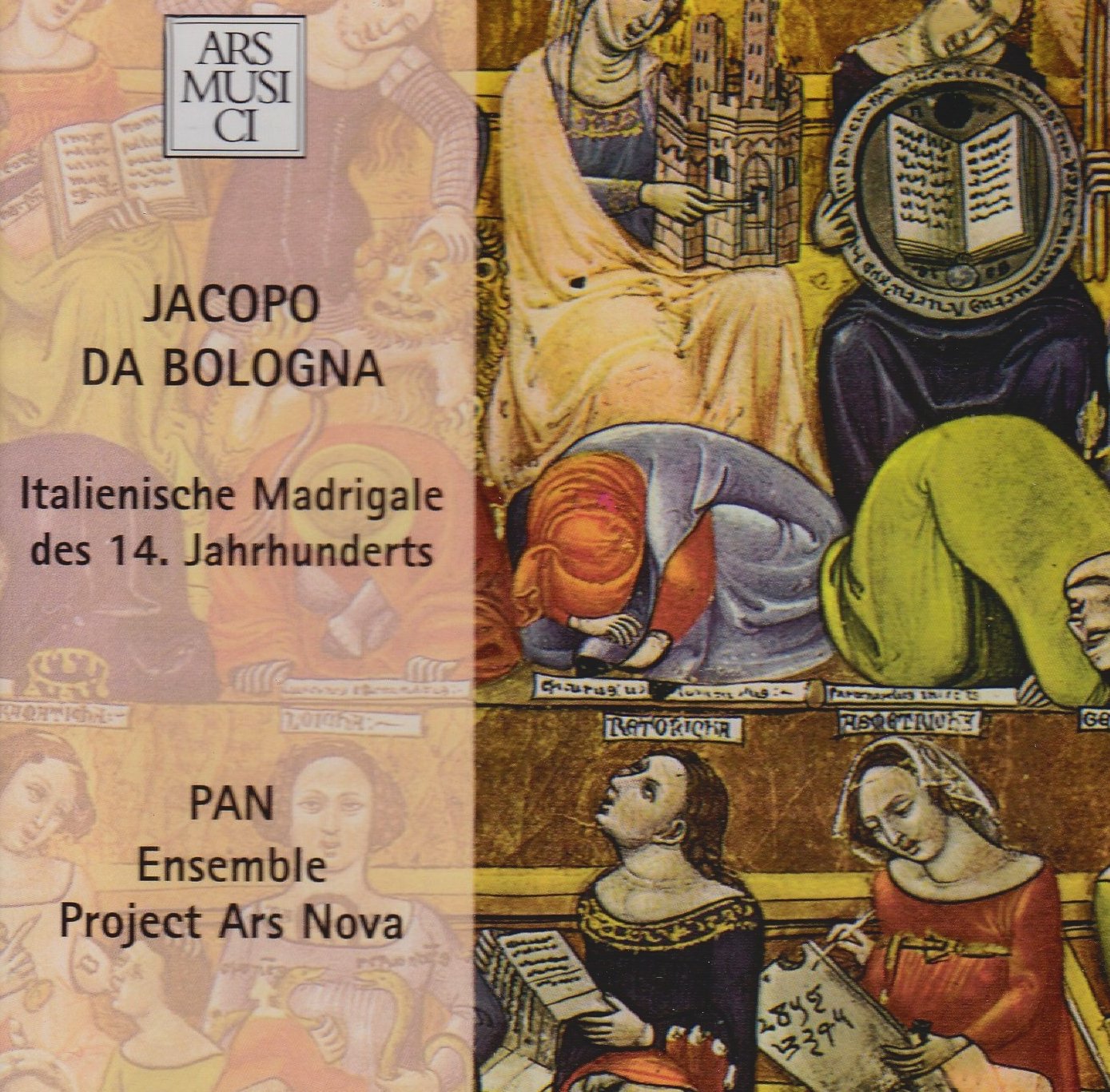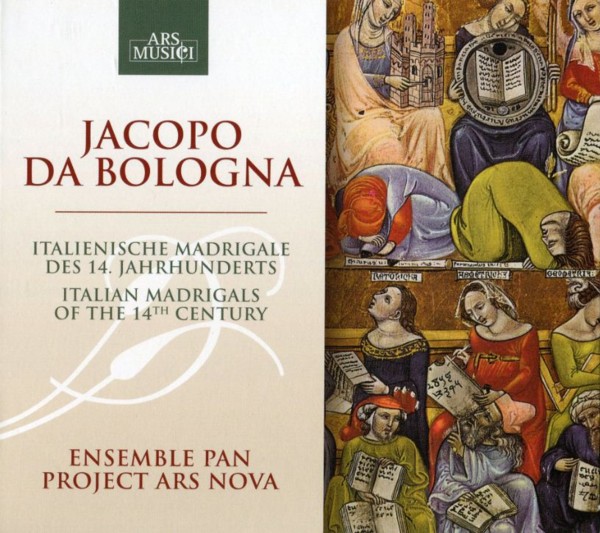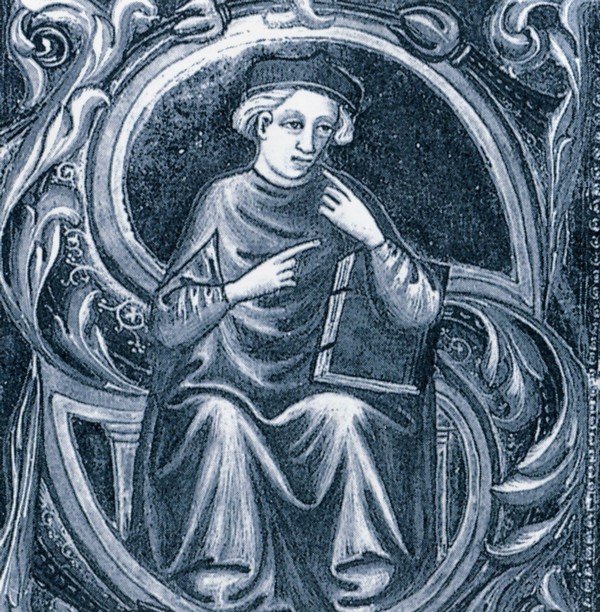Jacopo da BOLOGNA / PAN – Ensemble Project Ars Nova
Italianische Madrigale des 14. Jahrhunderts ·
Italian Madrigals of the 14th century

medieval.org
Deutsche Harmonia mundi HM 738 A (LP)
1985
Ars Musici AM 1274-2 (CD, 2001)
Ars Musici 232306 (CD, 2010)

1. Oseletto salvaço [2:26] Caccia
2. I'me sun un [2:03] Madrigal, instrumental
3. Oseletto salvaço [3:38] Madrigal
4. Prima virtute [2:08] Madrigal, instrumental
5. O in Italia [2:15] Madrigal
6. Nel mio parlar [3:38] Lauda / Ballata
7. Aquil' altera [2:34] Madrigal, instrumental
8. Aquil' altera ~ Creatura gentil ~ Ucel de Dio [4:00] triple Madrigal
9. Sotto l'imperio [3:39] Madrigal
10. Avendo me falcon [3:07] Madrigal, instrumental
11. Lo lume vostro [3:36] Madrigal
12. Lux purpurata radiis ~ Diligite justiciam [2:12] Motet
13. Non al so amante [1:47] Madrigal, instrumental
14. Non al so amante [3:16] Madrigal
15. Posando sopra un'aqua [3:14] Madrigal
16. I'senti' çà [3:48] Madrigal

Ausführende:
Mitglieder des Ensembles PAN
Project Ars Nova
Crawford Young — Laute, Cetera
Laurie Monahan — Mezzosopran
Michael Collver — Contratenor, Cornetto
Sterling Jones — Fidel, Rebec, Organetto, Laute
[Willem de Waal — Baritone]
Ensemble PAN
Ensemble
Project Ars Nova draws its name from the title of the 14th-century
music treatise Ars Nova (c. 1322), written by the French composer and
theoretician Philippe de Vitry. While the primary concern of the
treatise was to delineate the newly evolved means of notating rhythm,
the term “Ars Nova” began to be used in a general sense to describe the
new musical forces of the 14th century that collectively formed a “new
art”. PAN has borrowed the term and used it in this spirit. Ensemble PAN
specializes in this late medieval repertory, an art form created by
people with passions not so dissimilar from those of modern society.
Members of the Ensemble met while working at the Schola Cantorum in
Basel and founded the group in 1980.
Quellen [Handschrift]:
PARIS, Bibliothèque nationale, f.n.a.fr.6771 ['Codex Reina']
PADOVA, Bibliotheca Universitaria, Mss. 1475
FLORENZ, Biblioteca nazionale centrale, Panciatichiano 26
Instrumente:
Laute (4-chörig): (bundlos): Richard Earle, Basel 1982
Laute (5-chörig): Joel van Lennep, Rindge, N.H. (USA) 1982
Cetera: D.R. Miller, Gloucester, Ma. (USA) 1980
Rebec: Eugen Sprenger, Frankfurt 1962
Fidel: Fabrizio Reginato, Fonte Alta 1970
Organetto: Klaus Ahrend, Loga-bei-Leer 1963
Cornetto: Jacques Lepuy, Paris 1975
Aufnahme/Recording: Meinrad Schweizer
Aufgenommen/Recorded: 1985, Musikakademie der Stadt Basel
Titelbild/Front cover picture: Miniatur von Niccoló da Bologna
(14. Jahrhundert, Mailand, Biblioteca Ambrosiana)
Rückseite/Back cover: Miniatur des Jacopo da Bologna (Initiale im Squarcialupi-Codex)
Redaktion/Editing: Jens Markowsky
℗ 1985 deutsche harmonia mundi
© 2010 M.A.T. Music Theme Licensing Ltd.
All rights reserved

Magister Jacopo da Bologna
flourished from c. 1340-60, and played a major role in the beginning of
composed Italian polyphony. Jacopo, like his contemporary Marchetto da
Padova, came from a university town well-known as a center of musical
study. Whether he received his training in a clerical school or had
contact with the University in Bologna has not been established, and few
recorded biographical details of his life have survived. Text
references in his compositions indicate that he worked at the Visconti
court in Milano during the 1340's and at the Verona court of Mastino II
della Scala in the 1350's. Though little is known about Jacopo's
relationship with these patrons, the texts provide information about his
associations and activities in the two courts.
The history of
the Visconti court is a history of a power struggle within a family. It
was a struggle marked by violence, treachery, and plague epidemics.
Jacopo was at the court during the reign of Luchino (1339— 49), whose
administrative talents the composer praised in “Lux purpurata” and “Lo
lume vostro”. “O in Italia” celebrated the birth of twins born to
Luchino and his wife Isabella on August 4, 1346, however Jacopo's
references to court intrigues and treachery are less explicit. “Lo lume
vostro” includes a possible allusion to Luchino's nephews who conspired
against him and were subsequently banished. When the 'Black Death'
struck Milano in June 1348, Jacopo managed to survive, but his patron
Luchino died shortly thereafter on January 21, 1349. Although he may
have succumbed to the plague or another illness, references by
contemporary chroniclers hint that he was poisoned by his wife, the
beautiful and reportedly unfaithful Isabella Fieschi. “Posando sopra un'
acqua” refers to a beautiful woman who had changed into a deadly
serpent, and similar references to a treacherous beauty are found in
“Sotto l'imperio”. However, these references are vague, and their
connection to Isabella is conjectural. “Prima virtute” describes the
first virtue as knowing when to be silent — perhaps a sarcastic comment
on the fact that no formal charge or investigation was made against
Isabella after her husband's death. The composer left the Viscontis for
employment at the Scala court in Verona shortly after Luchino's demise;
whether he was forced to leave is not known.
Jacopo's engagement
in Verona coincided with that of two other composers, Magister Piero and
Giovanni da Cascia. Their work at the court of Mastino II della Scala
was of a competitive nature, as the three attempted to outdo each other
in their compositions. They chose similar themes and names, and
sometimes even set the same texts. This competitive spirit can be seen
in the text of “Oselletto salvaco”, where Jacopo criticizes his rivals
for trying to compete with true masters: Filipoti (Philippe de Vitry),
Marcheti (Marchetto da Padova), and Fioran (a singer associated with
Petrarch). Jacopo's fondness for sarcasm is again evident in the
ritornello: “Thus the world is so full of masters that one can no longer
find the students”. The artistic activity in Verona was stimulated by
more than just the competitions of Jacopo, Giovanni and Piero. Dante
stayed at the court of Mastino's uncle Cangrande della Scala. Marchetto
da Padova's important treatise concerning Trecento music theory, the Lucidarium,
was completed in Verona. Petrarch was also in Verona, and it is likely
that Jacopo composed the music for “Non al suo amante” at this time. It
is also possible that Jacopo's contact with Petrarch continued in the
1350's, as Petrarch permanently settled in Milano (1353-61), and Jacopo
appears to have reestablished contact with the Viscontis after 1352.
Whether he remained at the Visconti court or lived past 1360 we cannot
be sure, but his reputation continued and was documented in
fifteenth-century literature and music. Prudenzani's Il Solazzo
(1410-20) describes a performance of “Aquila altera”, and the
contemporary “Faenza Codex” contains ornamented instrumental versions of
“Aquila altera”, “Non al suo amante”, “I'me sun un che” and other
Jacopo compositions. Although the Faenza ornamentive style dates
considerably later than Jacopo's compositions, and is basically
idiomatic to a keyboard instrument, the “Faenza Codex” is nevertheless
an invaluable source of information concerning the performance of
Jacopo's music by a later generation of Italian musicians.
Ensemble PAN





